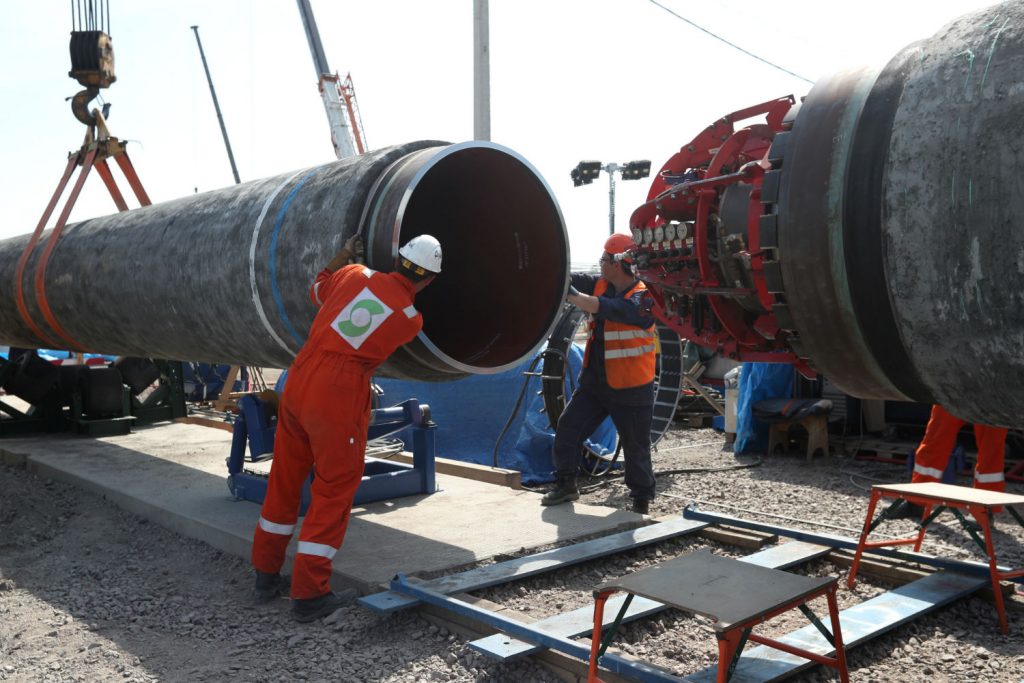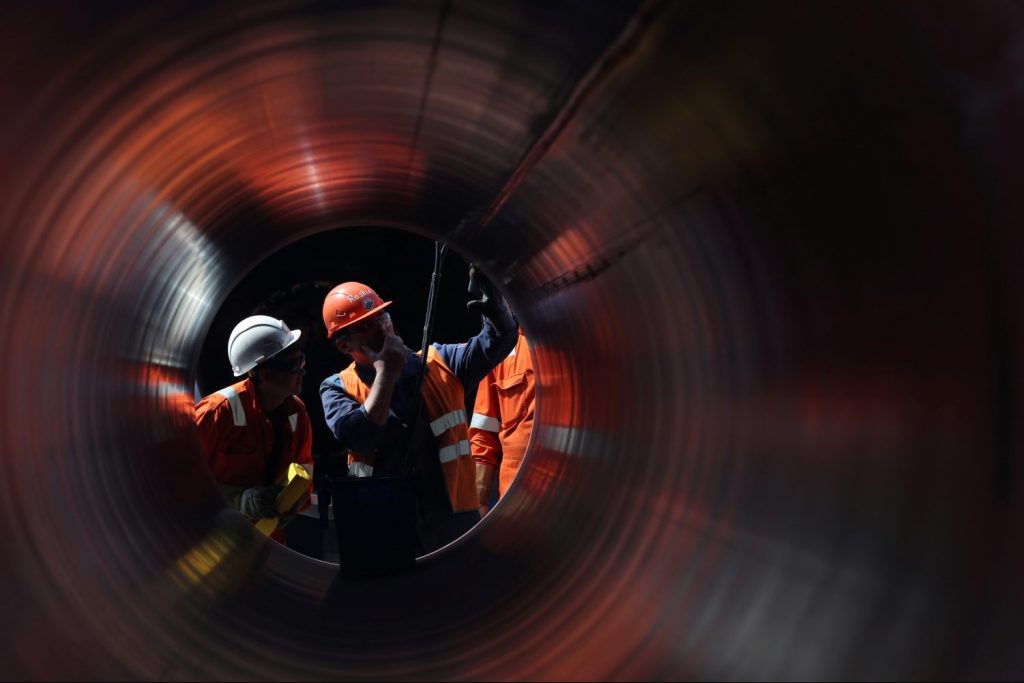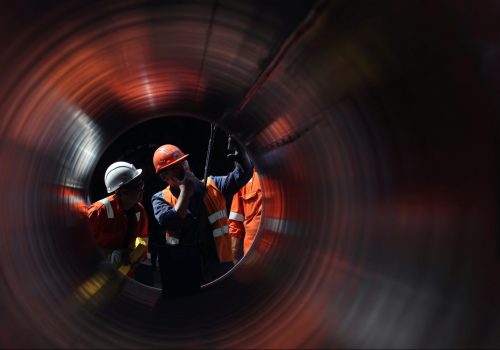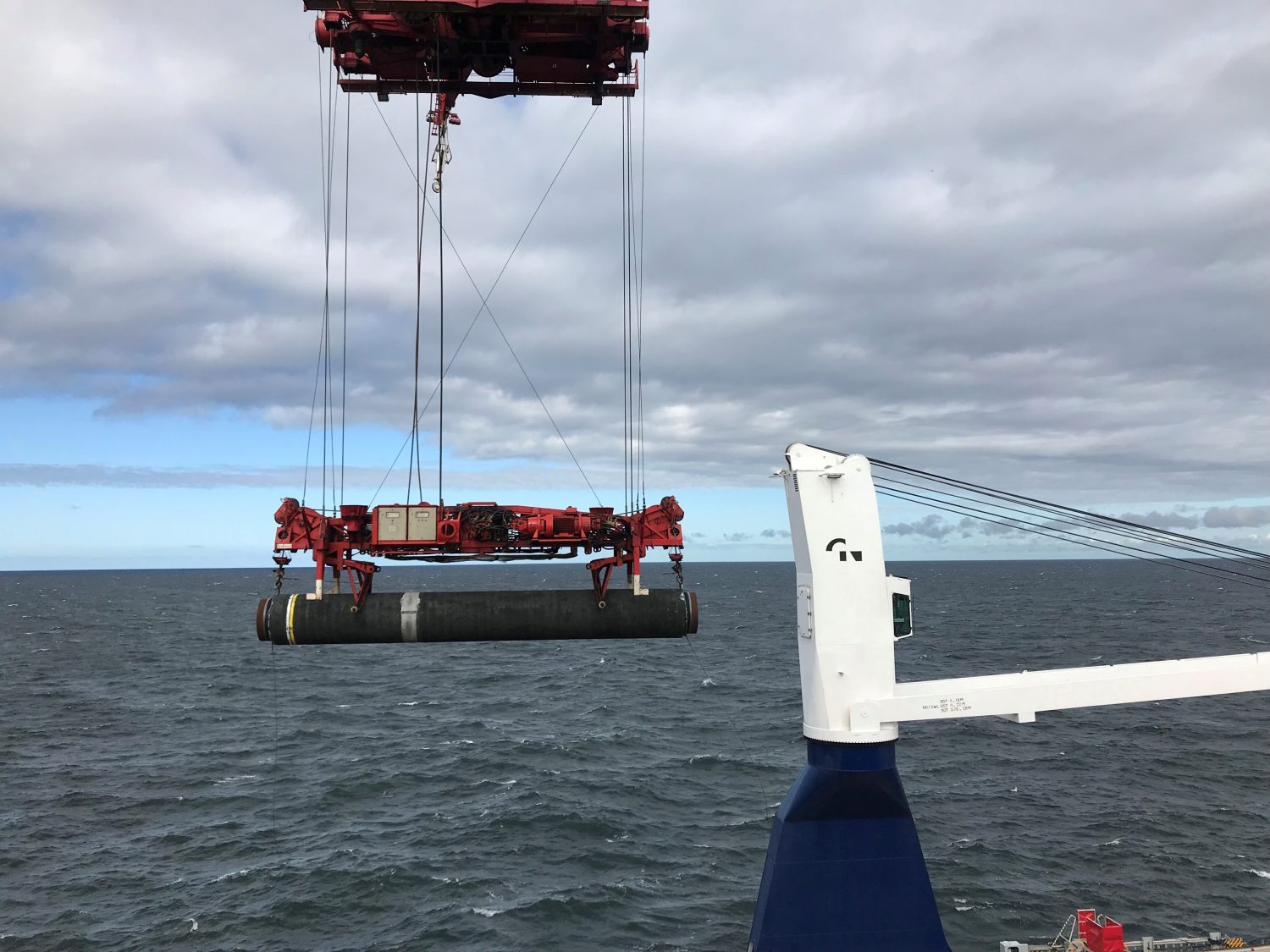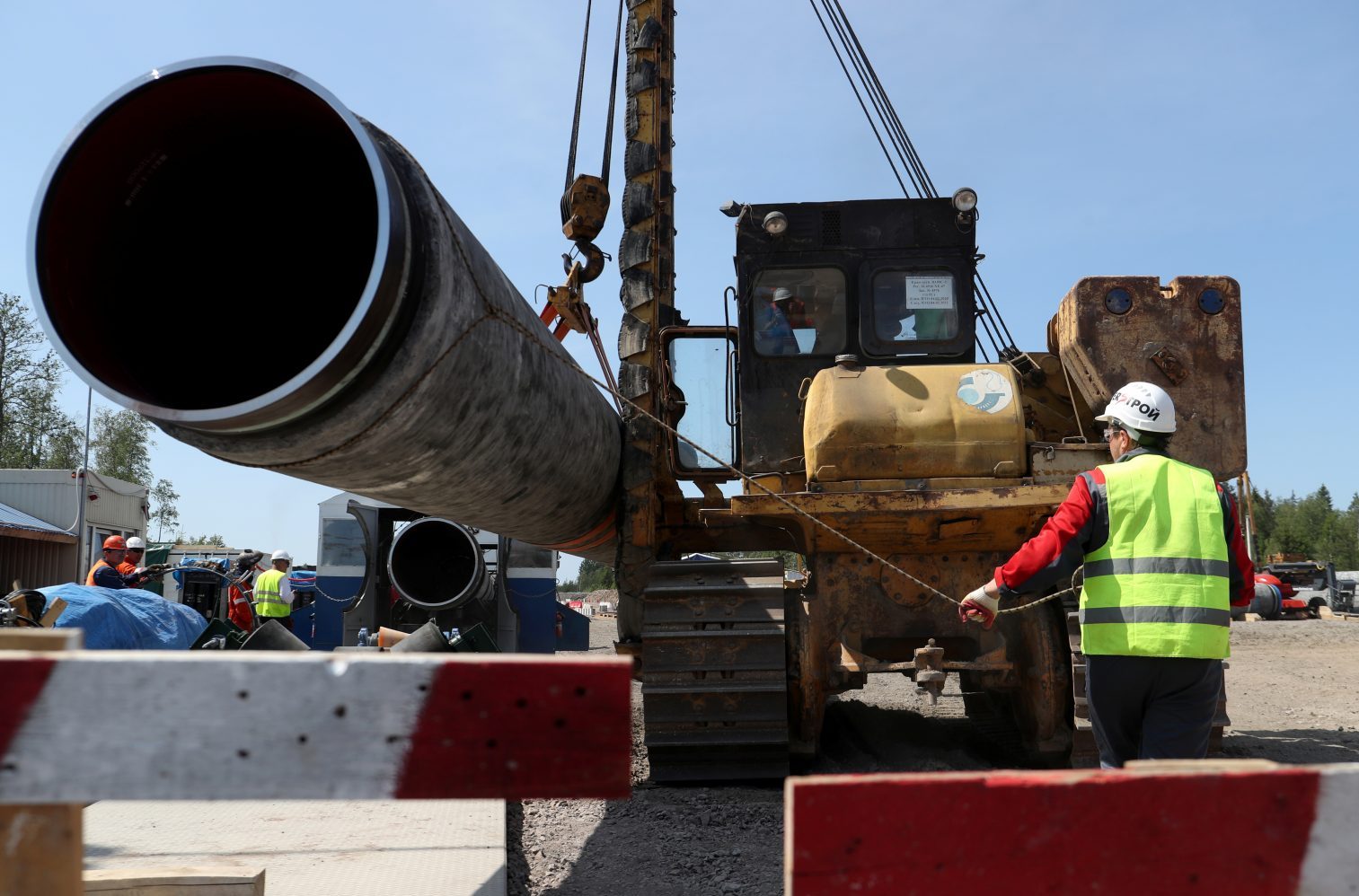Congress is poised to impose sanctions on the Nord Stream II gas pipeline project, a project long opposed by Ukraine, Poland, the Trump (and before that Obama) administration, the previous European Parliament, many inside the former European Commission (albeit quietly), and even many Germans. Congress’s opposition to Nord Stream II is well founded. Yet enacting the sanctions mandated by the Protecting Europe’s Energy Security Act (PEES Act), for all its careful crafting, may not actually block Nord Stream II but may instead burden the US-German relationship. Rather than impose sanctions, the administration should waive them for now but prepare even stronger contingency sanctions to be implemented should the Kremlin once again use gas exports as political leverage against Ukraine, Central Europe, or the Baltics.
The Nord Stream II challenge
Nord Stream II, the Russo-German Baltic Sea gas pipeline project designed to deliver Russian gas to Germany directly is bad policy: it increases Europe’s dependence on Russian gas in contravention of the EU’s own stated energy objective of diversification of energy sources and increases Russian leverage over Central European consumers and governments whose countries rely on Russian gas supplies and transit fees, by allowing Russia to bypass them while continuing to supply German and other Western European energy markets. Nord Stream II thus divides the European Union energy market and EU cohesion generally. Aware of Moscow’s habit of seeking to dominate its neighbors, Central Europeans, especially the Poles, have been developing alternatives to Russian gas (including liquefied natural gas from the United States), with some success. But such a major reorientation will take years.
Similarly, since Ukrainians overthrew Putin-controlled President Viktor Yanukovych in 2014, Ukraine’s government has wisely developed alternative means of purchasing gas, including Russian gas, through pipelines from its western neighbors that bring Russian gas to Ukraine from the West (so-called “reverse flow”). These arrangements mean that Ukraine no longer purchases any Russian gas directly from Russia for domestic consumption, a major national security achievement that mitigates much of the Kremlin’s energy leverage over them. Still, while Ukrainians no longer face the prospect of gas shortages due to Kremlin cut-offs, Nord Stream II gives Russia the option of curtailing gas flows through the existing pipelines transiting Ukraine, thus depriving Ukraine of $3 billion dollars in annual revenues—right around 2.5% of Ukraine’s gross domestic product (GDP), from transit fees.
Many Europeans outside those countries most vulnerable to Russian pressure know these issues well, and opposition to Nord Stream II has been strong, even within the European Union’s own institutions. In December 2018, the European Parliament voted overwhelmingly against Nord Stream II. The EU has for years supported secondary gas pipelines to facilitate “reverse flow” to Ukraine and vulnerable EU member states in Europe. At the same time, the EU has sought to apply to Nord Stream II its own energy regulations, e.g., the EU’s 2009 Gas Directive, to chip away at Russian coercive energy leverage; in 2019, the EU amended (and strengthened) its related Third Energy Package policy to apply to offshore pipelines, such as Nord Stream II.
These steps together are slowly weakening Russian gas leverage over Europe. But it still exists and will for years to come. Nord Stream II will prolong it. Notwithstanding the concerns of its neighbors and allies, the European Parliament (at least, the previous one), and many within the European Commission, Germany has pressed ahead with the project, partly because it unwisely decided to phase out nuclear power just as it was also phasing out coal for sound environmental/climate change reasons.
While Germany has laudably supported reverse pipeline projects and other means of mitigating the potential strategic risks of its own project, it has not done so with effort commensurate with the challenge. Instead, it has pressed ahead with Nord Stream II, which now appears to be at a late stage of the deep-water phase of construction.
Congress’s sanctions solution
The US Congress has stepped in and put the “Protecting Europe’s Energy Security Act” (PEES), originally introduced by Senators Ted Cruz (R-TX) and Jeanne Shaheen (D-NH), into the National Defense Authorization Act, a massive piece of legislation likely to pass in Congress and be signed soon by US President Donald J. Trump.
Unlike some Russia sanctions legislation that is more retrospective, punitive, and unfocused, PEES concentrates on the policy objective of blocking Nord Stream II; and the final version seems more carefully crafted than earlier versions. Its focused sanctions include mandating visa bans and full blocking sanctions against vessels and their companies engaged in gas pipe-laying at sea depths of 100 feet or more. That targets an area of pipeline construction in which Russia appears to be dependent on Western technology. (PEES also covers TurkStream, another problematic Russian pipeline project with many of the strategic downsides as Nord Stream but is now essentially complete and reportedly near operational.)
PEES provides for a wind-down period of thirty days after enactment for companies to pull out of Nord Stream II and includes a number of carve-outs, including an exception for repair and maintenance of the pipeline, specifically including environmental remediation.
In a nod to ongoing EU efforts to reduce Russian energy leverage over Europe, PEES also includes a sunset clause that would lift sanctions against Nord Stream II should the president certify that two conditions have been met. The idea of a sunset clause is laudable, but the details make it an impractical tool. The first condition for sanctions sunset certification is that Russia has lost the ability to use Nord Stream II as a tool of coercion. That’s an intriguing approach, but PEES makes a criterion of that condition the determination that the Russian government no longer owns or controls Nord Stream II’s transmission network, which seems a near-impossible standard to meet as long as state-controlled (or Putin-crony controlled) companies dominate Russia’s energy sector. The second criterion for sunset certification—that Nord Stream not result in a decrease of gas transit through existing pipelines of more than 25 percent—reflects a reasonable standard to determine whether the Kremlin is again resorting to use of gas flows for political leverage.
While the sunset provision is probably not usable, however, PEES provides a broad national security waiver authority, allowing the president to waive all sanctions on the basis of US national security interests—a low bar compared to other sanctions waiver authority the Congress has given the Trump administration for Russia-related sanctions—and a report to Congress.
The problem with sanctions
PEES assumes that even at this late stage of Nord Stream II construction, the pressure of US sanctions will frighten away Western companies and the project will halt. This is possible.
But it is also possible that because Nord Stream II is sufficiently close to completion, the Russians will find a way to complete the last pipe-laying portions of the project. (A cut-rate approach to undersea pipe-laying would raise the odds of engineering failure and/or environmental disaster, but in that case the Russians could use PEES’s carveout for pipeline repair, maintenance, or environmental remediation to hire a Western firm willing to make the needed fixes.) In any case, PEES’s sanctions are solely focused on blocking Nord Steam II’s completion; it does not offer options should the project be completed.
RSVP for the 12/19 event:
Regardless of their impact (or lack thereof) on the Nord Stream II project, imposition of the sanctions will trigger a major political problem with Germany which, despite its policy misstep with respect to Nord Stream II (and Nord Stream I, its no-better predecessor), remains critical to the transatlantic effort to limit and hopefully roll back Russian aggression against Ukraine and thwart Russia’s broad panoply of other bad behavior. Even Germans who oppose Nord Stream II oppose sanctions against it. For sake of historical context, the Reagan administration tried to impose sanctions against Western companies for their role in supporting Soviet gas pipelines to Europe but had to back down in the face of intense allied opposition.
In short, PEES attempts to deal with a real problem in a serious way. But applying its sanctions would trigger a distracting fight with Germany, with which US relations are already strained. And sanctions might not work.
Another course: contingency sanctions
The administration could choose to use PEES’s broad national security waiver authority and not implement the sanctions. But doing that and little else with respect to Nord Stream II would trigger objections that the administration was rejecting the will of Congress; siding with aggressive, authoritarian Russia against democratic Ukraine; and ignoring the energy security concerns of Poland, one of most pro-US countries in Europe whose government is among a small number in Europe on good terms with President Trump, and of other vulnerable Central Europeans.
The administration could, however, couple a waiver of PEES’s sanctions with a commitment to use existing sanctions authorities (either CAATSA Section 232, existing Obama-era executive orders from the Russia sanctions program, or both) to impose new sanctions on Russian targets should the Russian government use Nord Stream II or any other gas pipeline system as a means to coerce or exercise political leverage over Ukraine or any other European country (possibly mentioning Poland, the Baltics, and perhaps other Central European countries in this context). That trigger for such sanctions could draw from PEES by also pegging the contingency sanctions should Russia reduce gas flows through existing pipelines by more than 25 percent relative to the monthly volume in 2019.
The administration would have to make clear that it would not launch such sanctions for trivial reasons but only in response to Russian coercion using gas. The administration should also note CAATSA Section 232’s provision that requires consultation with allies before imposing sanctions (a substantively sound move that has the added advantage of addressing Congressional complaints that the administration does not use CAATSA enough). The Trump administration would face an issue of credibility should it exercise the waiver provision, as some would regard its commitment of contingency sanctions as unreliable; a sufficiently strong announcement and coordinated rollout of the contingency sanctions could mitigate that problem.
The details of such contingency sanctions need not be noted explicitly in the formal administration announcement of the waiver but would have to be planned in advance of any waiver announcement and consulted with key European stakeholders. In addition, examples of such contingency sanctions should be put out into the public domain simultaneous with the waiver announcement—possibly through background briefings—with enough specificity that the waiver and contingency sanctions announcement would be credible.
Such sanctions would have to be broader than the PEES provision that target only Nord Stream II construction. They should focus on the energy sector (along lines of making the punishment fit the crime) but need not be tied to Nord Steam II, narrowly defied. Options include:
Imposing financial restrictions on Gazprom (subjecting them to the US government’s financial sector sanctions already imposed on major Russian state banks). So far, Gazprom (the state-owned Russian company that is Nord Stream’s ultimate corporate backer) has not been directly subjected to sanctions, partly due to European concerns over gas supplies. But should the Russians resort to another round of gas coercion against European countries, Gazprom should no longer be considered off limits.
Escalating technological restrictions for gas and oil exploration equipment. US sanctions have so far targeted oil rather than gas exploration technology and had limited oil extraction technology restrictions to so-called special oil projects (arctic off-shore, deep-sea, and shale/fracking). If the Russians were to engage in a new round of gas coercion, gas extraction should not be off limits. The US government could develop sanctions options on a national (i.e., unilateral) basis, but to avoid commercial disadvantage to US companies, it should make clear to European and other Group of Seven governments that the United States will not tolerate so-called backfilling (European or other companies filling orders should US suppliers withdraw), and could invoke in this context the provisions in CAATSA that provide for secondary sanctions with respect to sanctioned Russian persons.
Intensified financial restrictions on all energy development projects. The United States would also seek European consensus to join us in these contingency sanctions, while making clear that should Russian malign behavior make such sanctions necessary, it would enforce these restrictions broadly, including through imposition of secondary sanctions.
The German government has objected to Nord Stream sanctions and appears to regard PEES’s imminent passage with apprehension. The prospect of a waiver of sanctions ought to relieve Berlin and ease a point of major friction. That is a good thing. But in return the US government should make clear that it expects German cooperation in developing contingency sanctions, including those suggested above and possibly others.
Through PEES, Congress is putting pressure on the administration to address the challenge of Nord Stream II (and TurkStream) and, more importantly, the accumulation of Russian energy leverage. Legislation is seldom the best vehicle to develop good sanctions policy, but Congress has acted given understandable doubts about the administration’s (and president’s) approach to Russia.
The administration will have to respond when PEES becomes law, which is likely, either by imposing sanctions to seek to block Nord Stream II, by waiving the sanctions, or by finding a third option. Among these choices, the third option seems the best choice, assuming that the Trump administration is able to implement a nuanced approach.
Daniel Fried is the Weiser Family distinguished fellow at the Atlantic Council. He was the coordinator for sanctions policy during the Obama administration, assistant secretary of State for Europe and Eurasia during the Bush administration, and senior director at the National Security Council for the Clinton and Bush administrations. He also served as ambassador to Poland during the Clinton administration.
Further reading:
Image: Workers are seen at the construction site of the Nord Stream 2 gas pipeline, near the town of Kingisepp, Leningrad region, Russia, June 5, 2019. REUTERS/Anton Vaganov
